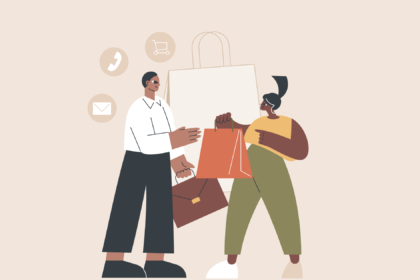Making steady money as an online merchant is simultaneously as easy and as hard as it has ever been. It’s easier to make a store (good), but harder to stand out (bad). It’s easier to reach prospective customers (good), but harder to keep them (very bad indeed). On the whole, though, the industry is in a good place: cover all the bases, and you have a great shot.
First base to cover: your retention rates. They’re absolutely key to your profits. The longer you keep a customer, the more money they’ll spend with you, and the more good they’ll do for your general brand image through unpaid (and often unprompted) advocacy. And to keep a customer, you need to make them happy.
The longer you keep a customer, the more money they’ll spend with you.
It all comes down to positive customer experiences, then: ensuring that someone who arrives at your store has their requirements catered to and heads off with a desire to buy from you again. Let’s run through some simple tips for bolstering your CX, then take a more specific look at what a positive customer experience does for you:
Simple tips for optimizing your CX
Before we look at some of the major ways in which positive customer experiences can keep people loyal to your brand and bring in new customers, let’s review some simple tips for enhancing your CX:
- Improve your delivery process. Irritation while waiting for shipping is a huge cause of customer dissatisfaction. Using a cloud system will make your life markedly easier through giving you the in-depth data you need to keep your customers informed.
- Offer a 24/7 support channel. You don’t need to have sales assistants online at all hours of the day — set up a chatbot to answer some common queries. That way, a shopper visiting your store at 2am will still be able to get what they need.
- Choose your CMS carefully. Having the right content system is hugely important for ensuring reliable performance, cross-device viability, and updated features, to name just a few things. Popular cloud-based hosted platforms include BigCommerce and Shopify — be mindful of your particular needs when comparing the platforms, and remember that merchant support is essential.
- Proactively seek feedback. If you just wait for people to tell you when they’re unhappy with your business, you’ll miss a lot of valuable feedback from those who simply leave when they’re dissatisfied. Don’t wait for comments: seek them out, and act on them.
- Understand your customers. You can’t deliver what your customers need if you don’t’ know what they need. Do your research (social media is great for this), ask questions where possible, and make sure that you know your audience before you try to sell to it.

Good CX establishes your business as reliable
Ecommerce may be a firmly-established industry by now, but it still presents various reasons for shoppers to be wary. For a start, there’s the complexity of distance selling, and the logistical issues than can arise from turning to the return process (whether driven by a faulty product or a conclusion that an item is unwanted).
There’s also the matter of data security. Pay in a brick-and-mortar store, and it feels reasonably safe — pay online, and you can be forgiven for expecting your data to end up leaked or used to blackmail you. Think about the high-profile customer data leaks of recent years, and how much more aware the average consumer has become of how massively things can go wrong.
Every good experience with your store factors into a broader pattern: deliver consistently for a while, and trust concerns will evaporate. You’ll become a trusted merchant, pushing buyers to place larger orders with you (and give you the benefit of the doubt when uncertain about the quality of something you’re offering).
It engenders powerful brand attachment
While it might seem on the surface of things that there’s no compelling need to be attached to particular brands today, we still do it, because we can’t help it. We’re tribal creatures by nature. We like to sort the world into allies, enemies, and unknown quantities. And while this always applied to the businesses we buy from to some extent, the impact of social media on how we view professional conduct has made us even more likely to view brands this way.
We’re tribal creatures by nature.
And when you’re attached to a brand, you feel a sense of pride in your good taste, and get to think of yourself as a community influencer in some regard: helping people make good choices by pointing them towards the brands you use. If all goes well, you get some credit, and get to enjoy having your choices validated by your peers.
This is where personal recommendations enter the equation. An isolated customer experience doesn’t have isolated effects. Truly impress someone with the quality of your business and customer service, and they’ll more than pay that value back through endorsing you — maintain a referral system with some minor incentives to get the ball rolling, and you’ll see the benefits.
It raises the opportunity cost of going elsewhere
Opportunity cost is an interesting thing to consider when it comes to buying online, because it can easily feel impossible to calculate with any degree of confidence (and thus close to meaningless). If you don’t know whether you could find a product cheaper elsewhere, but there are so many other stores that you’d never be certain you’d found the cheapest listing, then you might as well forget about price as a primary metric and simply go with the first one you saw.
By providing extensive positive customer experiences, you establish a daunting opportunity cost for other retailers in your industry. Every time a shopper is tempted to buy from someone else (and such instances will arise, due — for instance — to varying prices and temporary promotions), a question will arise for them: “Would I be better buying there again?”.
By providing extensive positive customer experiences, you establish a daunting opportunity cost for other retailers in your industry.
Make no mistake: there’s a lot of power in being the safe, default option. Quite often, you’ll see an offer online that seems too good to be true, and you’re called upon to balance the risk and potential reward of going for it. Get burned once or twice, and you don’t feel like risking it again, so you turn to the brand you can trust.
Adopt the customer success mindset
You may have heard of the customer success approach to ecommerce, and online UX in general. Very simply, it involves committing to maximizing your positive input in each customer’s journey, with your goal being to help them achieve theirs — whatever it may be, and however small a part you may play in proceedings.
It’s this mindset that you need to adopt if you want to really drive customer loyalty. If you keep looking for fresh ways in which to help your customers a little more, they’ll stick with you, avoiding the brutal churn so common in ecommerce and giving you a strong foundation.
A Little about LateShipment.com
We at LateShipment.com work hard to make “parcel shipping & delivery” transparent and help businesses be fully in control of their last-mile success.
Some of our high-impact offerings are:
- Automating refund claims from your shipping carriers for service failures to help you save money on shipping.
- Giving you full control over delivery delays that harm your brand and sales. You can now predict parcel delays and even fix them by keeping customers informed.
- Reporting at every stage of “shipping & delivery” to enable you with critical supply-chain insights.
The value we add to businesses is most evident when experienced first-hand. Learn more about our solution here.







